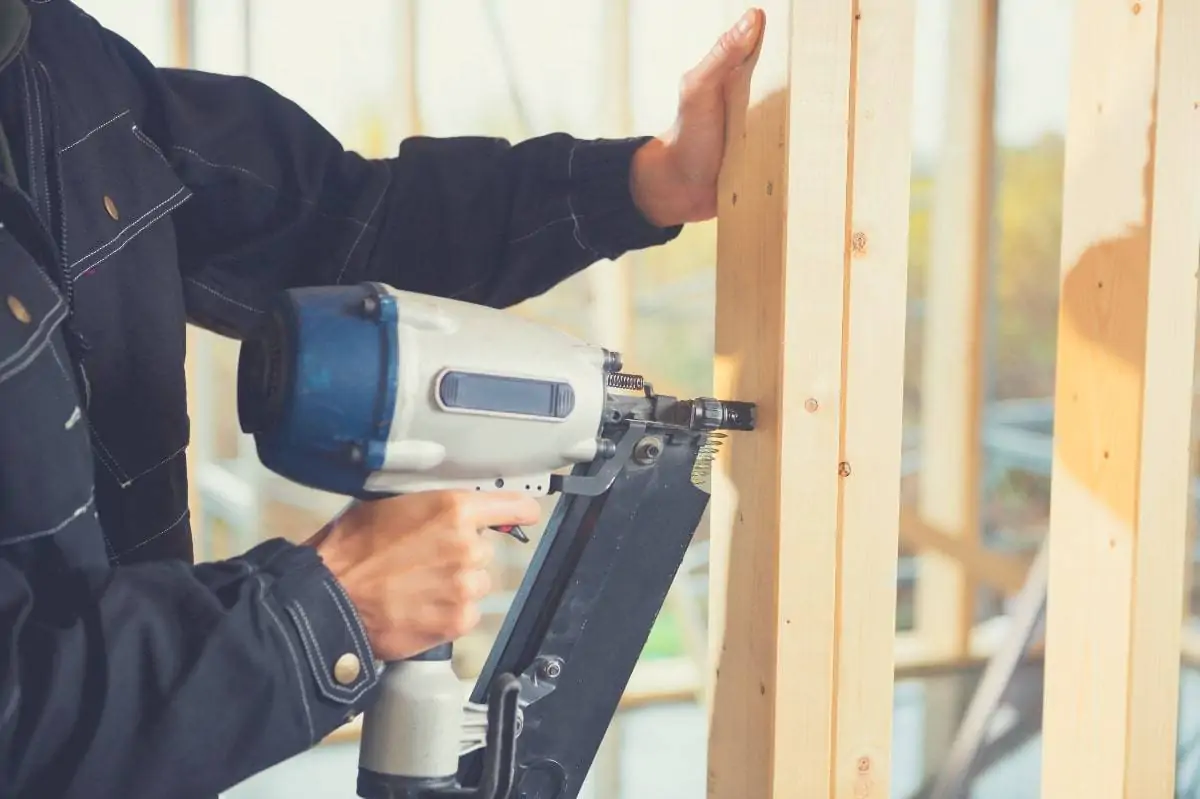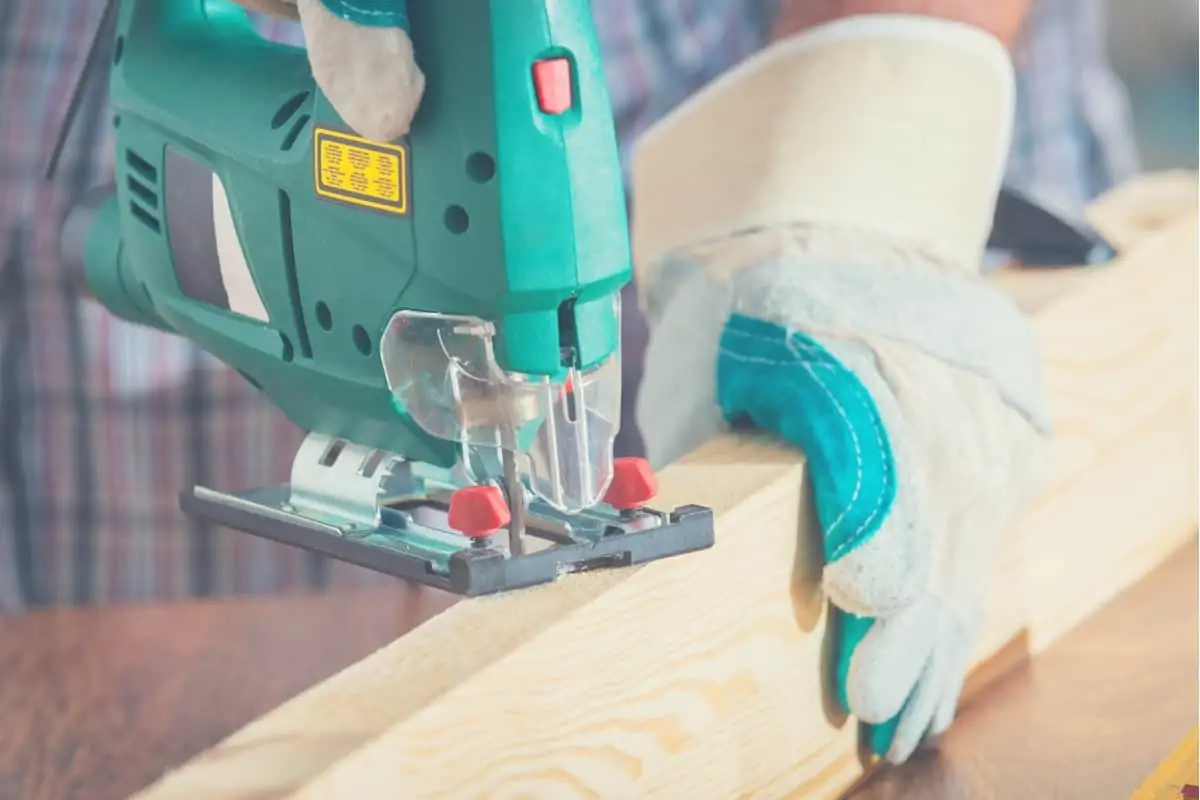If you’re launching into a new DIY project, you might be wondering how to use a circular saw. I used to be intimidated by these impressive bits of kit so I can understand why some people are put off by them.
But once you know your way around the tool it won’t take you long to become a circular saw master!
In this article I’ll cover exactly how to use a circular saw. Before I get there, I’ll go over the basics of the tool’s parts and what exactly it’s used for. Hopefully this will help you to make sure you’re using the right tool and that the instructions are easy to follow.
What is a Circular Saw and What is it Used For?
A circular saw is a power tool that features a circular blade. The blade rotates at high speeds to cut quickly through material. You can use a circular saw to cut a number of different materials, such as:
- Wood
- Plastic
- Masonry
- Metal
Circular saw technically refers to any motorized saw with a circular blade. However generally when people say circular saw they’re talking a handheld power saw with a circular saw blade of 6-½ or 7-¼ inches in diameter.
While circular saws can be used to cut a range of materials it’s most common to use them for carpentry and woodworking.
You can also get table-mounted circular saws, which are known as table saws.
A circular saw is used for making straight in material. It makes the job quick and easy, and is a common sight in both DIY toolkits and with professional carpenters.
Circular Saws vs. Other Power Saws
There are a load of different types of power saw out there. Some are perfectly designed for very specific jobs. However even the more common place, versatile power saws are better suited to some tasks rather than others.
Jigsaw
Circular saws differ from jigsaws as these are a type of reciprocating saw. A jigsaw is better for cutting more complex patterns in wood. This is thanks to the relatively small blade which makes it easier to change direction than a circular saw.
A circular saw on the other hand is better for making long, straight crosscuts across the grain or rip cuts along the grain.
Table Saw
A circular saw and a table saw on the other hand are both suited to making the same kind of cuts. However here the difference is a trade off is between accuracy and portability.
While a table saw is larger, heavier and takes longer to set up, the accuracy of a table saw is hard to match with a circular saw.
If you’re wondering whether you should buy a table saw or circular saw, the answer really depends on the types of job you’re likely to do.
Miter Saw
Finally, circular saws differ from miter saws because a miter saw is generally used for making clean, accurate crosscuts and can’t really be used for ripping.
Miter saws have adjustable miter and bevel angles and so can be used for cutting compound angles too too.
What’s the Best Type of Circular Saw?
Circular saws come in different varieties that each have their pros and cons. Below is a breakdown of the most popular kinds of circular saw so you can decide which is right for your needs.
Cordless vs. Corded Circular Saws
The first decision you’ll have to make is whether you want a corded or cordless circular saw.
This decision should be fairly easy to make because it’s ultimately decided by power and portability.
Corded Circular Saw
For a DIY toolkit, I’d recommend sticking with a corded circular saw. It’s unlikely you’ll be limited by a lack of wall outlet at home, and you’ll benefit from the greater power-to-money ratio.
Pros
- More powerful motor – can reach speeds in excess of 5,200RPM
- Better for cutting through tougher materials
- No danger of running out of battery
- Lighter weight (no in-built battery)
- Generally less expensive
Cons
- Limited by access to power outlet
Cordless Circular Saw
If you’re a professional who needs to be able to use their saw on any job site, it might be worth the investment in a powerful cordless circular saw.
Pros
- More portable – no need to find wall outlet
- Safer – no danger of cutting through power cord
- Easy to use
Cons
- Usually not as powerful as corded equivalent
- More expensive than comparative corded model
Sidewinder Circular Saws
A sidewinder circular saw uses a spur gear to drive the blade. The gear sits inline with the blade and allows it to spin at speeds of up to 6,000RPM.
Setting the motor up in this way results in a compact circular saw. It also means the blade is mounted to the right, making them good for left-handed people.
Pros
- Good for cross cuts and use on softer wood
- More compact saw
- Lightweight
- Right-mounted blade good for lefties
- High RPM
Cons
- Low torque
- Not as good for rip cuts and hard wood
Worm Drive Circular Saws
Worm drive circular saws use a spiral gear that’s mounted at a right angle to the blade. Setting it up in this way means more torque, but lower blade speed. You’ll reach about 4,500RPM with a worm drive circular saw.
Having the motor at a right angle to the blade means the saw is longer than a sidewinder. They’re also heavier and offer less cutting control. Worm drive saws are generally better for more experienced users.
Pros
- Blade is mounted to the left – better for right-handed people
- More torque
- Better for rip cuts and hard wood
Cons
- Lower RPM
- Heavier saw means it’s more difficult to handle
- Gears must be oiled regularly
Hypoid Circular Saw
Hypoid circular saws have a different gear arrangement, but it’s closer to a worm drive saw. The saw has a spiral bevel gear that offers great torque but doesn’t require maintenance.
A hypoid saw has a sealed gear mechanism, meaning there’s no need to oil them regularly. They’re heavy pieces of kit though, and so are harder for less experienced woodworkers to handle.
Pros
- No need to maintain gears
- High torque
- Great for rip cuts and hard wood
- Left-mounted blade is good for right-handed people
- Quieter to operate than worm drive saws
Cons
- Quite expensive
- Harder to handle
- Heavy piece of kit
Which Saw Should You Choose?
When it comes to which type of circular saw you should buy, the answer depends on a few factors.
For example, if you’re new to DIY, you might be best to buy a sidewinder circular saw. They’re the lightest and so are the easiest to handle.
But if you’ve got experience using power tools and have the budget, go for a hypoid circular saw. They’re more expensive than worm-drive saws, but this is offset but the lack of maintenance.
Finally, your dominant hand should play a part. There’s nothing stopping a rightie using a worm-drive saw, but it might impact your ability to see the cut line. Bear this in mind when making a decision.
Parts of a Circular Saw
Knowing the parts of a circular saw is useful for identifying any issues and for maintenance. Below you’ll find a brief summary of the important parts of a circular saw.
Motor
This is fairly self-explanatory. The motor is what provides the rotational power to drive the saw blade.
Depending on what type of circular saw you own, the motor will either be mounted in line or to the side of the blade.
The power output will vary from model to model with power being the product of RPM and torque. For a given power a higher torque will mean a lower RPM and visa versa.
Blade
The blade does the cutting; you’ll find it at the front of the saw. It fits onto the arbor (the shaft in the middle), which is how you change between circular saw blades.
You’ll need different saw blades for different cutting jobs. Your saw blade needs to be the right size for the circular saw.
The most common sized saw blades you’re going to find are 6-½ and 7-¼.
Base Plate
The base plate is the part you rest on the material you’re cutting. It surrounds the blade for safety and is a helpful guide for lining up your cuts.
It’s also the part of the saw which will run along a guide or straight edge, if you’re using one to ensure you get straight cuts.
Front Grip
You use the front grip to steady the saw, and this will also act as your guiding hand. Your other hand holds the rear handle, where you’ll find the switch.
Having one hand to the front of the saw and one hand to the rear is part of what gives a circular saw so much control when making long straight rip cuts.
Retractable Blade Guard
This covers the blade when not in use, and moves out of the way when cutting. A blade guard always covers the top of the saw blade to prevent accidental contact while in use.
The blade guard also stops debris from flying your way while using the saw and ensures dust is directed towards the extraction if you have some.
On/Off Button and Safety Switch
Circular saws have a safety switch that you must press down along with the on/off switch. This prevents accidental use and ensures you’re ready to cut.
You’ll find both on the rear handle, often arranged like a trigger.
Base Plate Bevel Adjustment
The bevel adjustment is necessary for making angled (a.k.a bevel) cuts. It allows you to move the base plate to the desired angle and locks in place.
You’ll find it just off-center at the front of the saw. Bevel adjustments lock in place with a small screw or knob.
Laser Guide
Not all circular saws come with a laser guide, but they’re handy. It projects a straight line onto the material, allowing you to easily follow a cutting line.
A laser guide will either be mounted on the front pointing forward or on the base pointing down.
Notch
Circular saws have a small notch at the front of the base plate. You can use these to line the blade up with your cutting line.
But as the notch usually isn’t in line with the blade, they’re not very accurate. You’ll be fine using the notch for rough cuts, but use a laser guide for more accurate cuts.
Step-by-step Guide: How to Use a Circular Saw
Now that we’ve gone through all the useful information it’s time to get down to it! Using a circular saw doesn’t have to be difficult providing you follow these steps.
If it’s your first time using a circular saw, consider these tips:
- Cut with confidence. Most power tools can have a mind of their own, so be sure to put a bit of force into your cut.
- Measure twice, cut once. Materials can be expensive; don’t waste them through inaccurate cuts.
Step 1: Safety First
Be sure to tie up long hair and not wear loose clothing. Eye protection is a must, and you might want some gloves too.
If you’re cutting wood or masonry, a dust mask is a good idea.
Also, if you’re doing lots of cutting, ear protection might be worthwhile.
Step 2: Measuring and Marking
The first step should be to measure out where you’re going to cut. Mark this line with a pencil and ruler. If marking a straight line, consider using a setsquare for accuracy.
Be sure to mark the scrap side of wood too. I usually write ‘scrap’ or ‘cutoff’, but you could also mark it with an X.
Most importantly, you want to cut on this side of your cutting line. Doing so means you won’t lose any material on the good side due to the kerf (thickness) of the blade.
If you’re cutting along the length of the lumber, keeping a straight line can be difficult. Use a chalk line (string coated in chalk) for greatest accuracy.
Give the string a flick first to remove excess chalk and then pull up and twang it against your material. Carpenters have done this for centuries and it still works!
Using a Guide
While it’s possible to make a perfectly straight cut with a decent mark and a steady hand, sometimes a guide is a good idea, just to make sure.
To set the position of the guide you’ll need to make sure you take into account the distance from the edge of your base plate to the blade.
As the base plate will run along the edge of the guide this distance will have to be added on when measuring the position to set the guide.
Step 3: Securing the Work Piece
Secure your material to the work surface using clamps or a vice. You don’t want it moving around while you’re cutting, so get it as secure as possible.
You’ll probably have to clamp down on the bit you’re using. Protect it from dents with a small piece or cloth or paper under the clamp.
If you’re wondering how to cut small pieces of wood with a circular saw, then stop for a second.
Is a circular saw the best tool for the job? If you can’t see the material under the base plate, you’re heading for an accident. Consider switching to a manual saw for safety and accuracy. Or you could try a table saw.
Step 4: Saw Adjustments
Next you need to set the right cutting depth for the job. You should ideally set the blade depth to around 1/4 inch below the bottom of your material. This ensures you’re getting a good cut and making it all the way through.
Setting the depth any lower risks inefficient use of the blade. You’ll also increase your risk of injury. Getting the right depth will result in a cleaner cut too.
For example, if you’re cutting a 1” thick piece of lumber, a good depth setting would be somewhere around 1-¼ inch. This will make the most use of the blade.
Bevel Adjustment
If you’re cutting at an angle, now is the time to set it. Turn the bevel adjustment knob counterclockwise. Set the correct angle for your job, and then turn the knob back to lock it.
Step 5: Make the Cut
Now we’re at the important part: cutting. Providing you’ve done all the prep, this should be easy.
Start by lining up your blade. Use the notch, marked with 0 on the base plate. Alternatively, use the laser guide if your circular saw has one.
Put your dominant hand on the rear handle and your weaker hand on the front handle. This’ll be your guiding hand. Hold down the safety switch and squeeze the on trigger. The saw should start up.
Start the saw away from the edge of the material so the blade can reach full speed before you start cutting. Not doing so could damage the material or saw.
Push the saw into the material, holding it with confidence. The saw will do the cutting but you’ll need to apply gentle a force to move the saw forwards and cut through the wood.
Although you used the notch to line up, ignore it now. Your best indicator for accuracy is the blade. Watch where this is going in relation to your cutting line. After all, it’s the bit doing the cutting.
Follow through the material until the saw has broken through the other side.Release the trigger to shut off the power. Be sure the blade goes all the way through before you take your hand off the trigger.
Troubleshooting
If your saw isn’t cutting in a straight line there could be several reasons. One is an unstable blade. Disconnect the power and double check the arbour nut is tight.
Or your blade might be warped. This happens with cheap blades and the only fix is to replace it.
If your circular saw keeps getting stuck in the material, it’s likely the blade is either dull or not fitted correctly. Check it over and replace or realign depending on the issue.
Step 6: Cleaning up the Edges
After making the cut, you need to clean up the edges. Go over them with a piece of sandpaper to smooth things down. Be sure to take off any sharp corners.
Tidy away your tools, clean down the work area, and you’re done!
Final Thoughts
After using a circular saw a few times I realized there was really nothing to be concerned about. Providing you take appropriate safety precautions, the saw will do most of the work for you!
Hopefully this guide has given you all the information you need on how to use a circular saw.
The first steps are choosing the best model for your needs and then measuring correctly. Only then can you hope to make accurate straight cuts with your saw.
As you grow in confidence you’ll develop your own little saw hacks for making life easier. Do you have any helpful tips already? Post them in the comments section below for other readers to enjoy.



